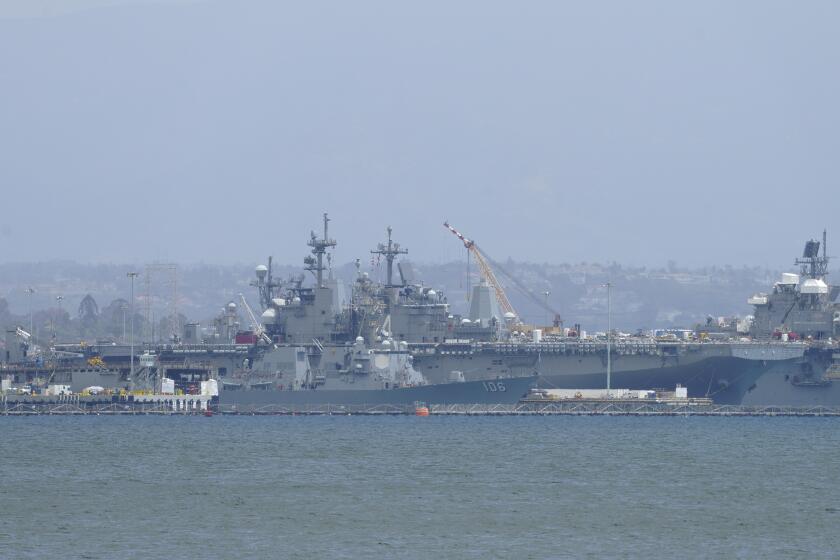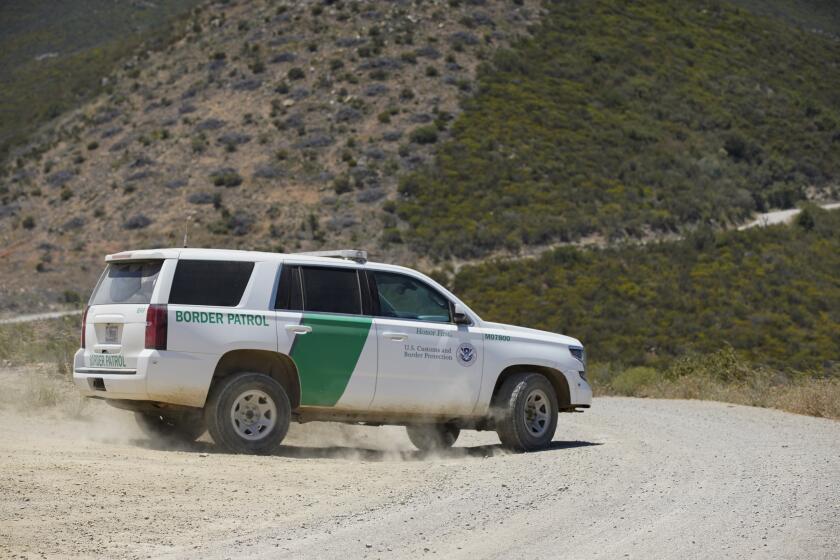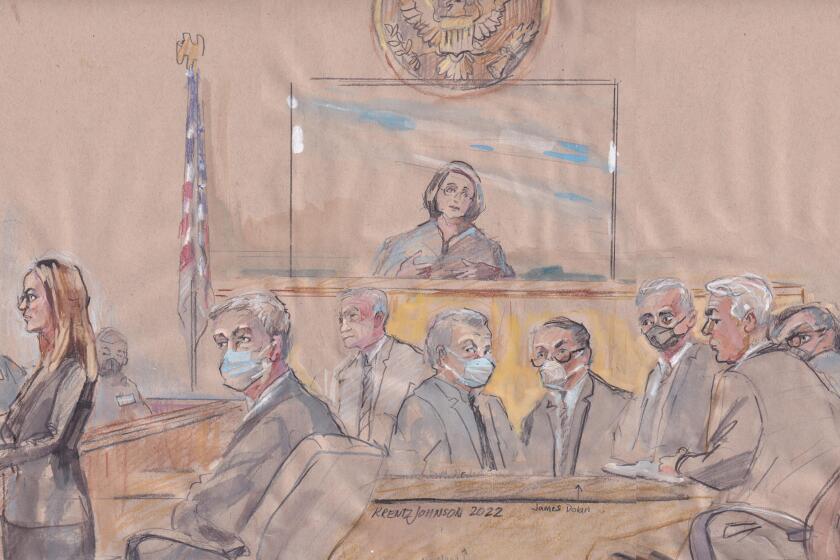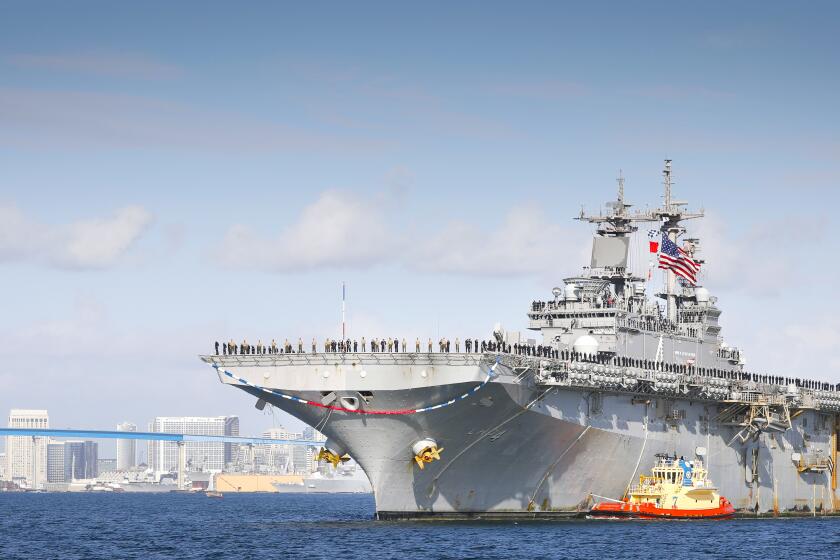Marine reunites with four-legged battle buddy
Two young Marines served their first combat tour together during the height of the fighting in Afghanistan, then went their separate ways. More war-zone deployments followed over the years for the decorated veterans. But all that time, Sgt. Andrew Mulherron never forgot his four-legged battle buddy.
Boone, a black Labrador retriever trained to detect explosives, walked point with the infantryman in 2010, where the pair hunted for roadside bombs that maimed and killed so many comrades. The dog had 11 confirmed finds of improvised explosive devices during his first combat tour and shared a Navy Marine Corps Achievement Medal with Mulherron.
On Thursday, the Marine and his former war dog reunited at Twentynine Palms when Mulherron returned from Iraq.
The combat missions have changed since their last patrol together nearly five years ago in the Laki area of Helmand Province. The IED Detection Dog program has been decommissioned, and Boone’s beard has turned gray.
But the bond between a Marine and his dog has endured.
“He still looks young,” Mulherron said, beaming as he watched the trim canine scamper around the baseball field at the welcome home party for the 3rd Battalion, 7th Marine Regiment.
Mulherron, a 26-year-old machine gunner from Bay Point, served with his infantry battalion as the ground-combat element for Special Purpose MAGTF-Crisis Response during a six-month deployment in the Middle East, where the unit of about 2,300 troops launched airstrikes, secured military bases and supported Iraqi national forces in Operation Inherent Resolve and the fight against the militant group ISIS.
The altered strategic landscape and Boone’s advancing age benefited the Mulherron family, allowing the Marine and his parents to adopt Staff Sgt. Boone out of retirement this month from military service. According to Marine Corps tradition, Boone outranks his handler in a sign of respect for the dog.
Boone’s return to California was a long journey involving the help of a dog-loving stranger, a Vietnam War-era Marine dog handler, relatives and friends.
The story began in Virginia in 2009, where Boone trained for months with Mulherron to detect explosives on foot patrols. It continued at Camp Pendleton during the work-up to deployment. As a lance corporal, Mulherron was one of 12 infantrymen from the 3rd Battalion, 1st Marine Regiment selected for the expanding bomb-dog mission.
At its peak, the Marine Corps had about 1,000 military working dogs, including those assigned to infantry and military police handlers. Today in the aftermath of major combat operations in Afghanistan, the service has about 375, including dogs currently deployed with 1st Marine Expeditionary Force personnel in the Middle East and aboard Navy ships.
Why do dogs serve in the Corps? They perform a variety of missions, from search to attack, making use of a nose about 400 times as sensitive as a human’s.
Plus, dogs can do things that technology can’t, said William Childress, a retired Marine who serves at the Pentagon as manager of the Marine Corps Military Working Dog program.
“The dog is more mobile. It can go to the source and get within 10 to 15 feet of the odor we’ve trained the dog to search for,” getting closer than mechanical detectors, he explained.
Another benefit is the relatively low expense compared to ground radar machines and mine rollers. “It’s not a costly program. All you have to do is be able to feed the dog, water the dog, housing,” Childress said.
What goes unmentioned is the idea held by some that dogs are more expendable than human personnel. But their handlers often consider them to be family.
Dan “Sugar” Miller, the battalion adviser who paired Mulherron with Boone, was a Marine Scout Dog handler during the Vietnam War. Despite the intervention of his congressman, his dog was put down after their 1969-1970 tour, like all the others.
Miller never got over it. “This haunted me for years, knowing I left my dog to such a fate,” he said.
In 2002, Miller tracked down the bloodline and recovered a fifth-generation canine from the same kennel. “That dog healed a deep wound,” he said, and inspired him to help Mulherron reconnect with his dog.
Mulherron appreciated Boone’s work ethic and fun attitude; off-duty, the dog is a champion dirt roller and ball fetcher. “Me and Boone from the get-go just had a connection,” the machine gunner recalled. “We were a great team and we got stuck together. Probably the best thing that happened to me.”
Marine tradition since World War II is to pair a handler with a dog of similar character. “Mulherron and Boone never stopped giving 110 percent,” Miller said. “There were days they both simply were dehydrated and running on empty, yet after addressing the issue, picked right back up and got back to work.
“All of our Marines did an outstanding job,” handling bomb-detector dogs on patrol, he added. “They saved countless lives while deployed in Helmand in 2010.”
The surge of Marines sent to confront the Taliban in 2010 had suffered heavy casualties.
In Garmsir district, Mulherron and Boone found dirt roads and paths riddled with explosives.
“That was a tough year, a tough deployment. It was hard on Andrew, but Boone helped him get through it. They lost a lot of friends,” said his mother, Nuala Mulherron.
Boone helped all of them, her son remembered.
“Me and him, we were always out front sweeping the roads. Everybody loved him, everybody trusted him. He had quite a few confirmed finds,” Mulherron said. “I remember every one of them.”
After the deployment, contractors were waiting for Boone when their C-17 landed in California. Mulherron had a few minutes to say a tearful goodbye.
“He had a hard time giving him up. They were together almost two years,” said his father, John Mulherron.
After that, Boone deployed again to Afghanistan with another Marine, to the minefields of Sangin. Then he was enlisted in the Army as a search-and-rescue dog, staying on after the IED Detector Dog program ended.
Mulherron returned to Afghanistan, then deployed twice more.
“Anytime he’d meet another dog, he’d say, ‘Oh, he doesn’t compare to my Boone.’ Everybody got sick of hearing about Boone,” his mother said, chuckling. “Even though he’s a big bad Marine, he’s got a soft heart when it comes to the dog. No one is supposed to know that.”
En route to Iraq in April, Mulherron and a United Airlines flight attendant started chatting on the long flight to Germany about her work rescuing dogs. Mulherron mentioned that he was trying to track down Boone.
“I’ll go get your dog,” Molli Oliver, 64, of Los Angeles, told Mulherron.
“I was just empowered by this Marine and his love for the dog,” she recalled.
After spending about $1,400, making several trips to visit Boone and reuniting another military dog with his former handler, Oliver brought Mulherron’s buddy to California.
On Oct. 5, she signed the paperwork at Fort Leonard Wood in Missouri to discharge N787 — the action number tattooed on Boone’s ear. Oliver flew him to Northern California, cuddled in a Marine Corps blanket. “Once a Marine, always a Marine,” she remarked.
At the Mulherron residence in the Bay Area, Boone quickly became long-lost brothers with Major, their yellow lab, helping the shy and abused puppy mill survivor come out of his shell and trim down with two-hour wrestling and play fighting sessions each night.
Major helped Boone learn to shrug off loud noises, which put him on alert like many combat veterans. Luckily, Boone has no signs of aggression or severe anxiety, the PTSD-like symptoms that afflict some bomb dogs.
But he was startled by the sound of a handyman with an air gun and he was a bit standoff-ish at first with the vacuum cleaner. When John Mulherron watches the Military Channel, Boone perks up at the familiar sound of helicopter rotors thumping.
Boone and his first Marine handler most recently saw each other during a brief meeting in 2011, when Mulherron tracked Boone down at Camp Pendleton before the dog returned to Afghanistan without him.
Boone “freaked out,” bounding with joy. On Thursday, would he still remember his first handler?
When Mulherron stepped off the bus at Twentynine Palms, Boone seemed more interested in his ball. But Mulherron was patient. “It’s been three years since he’s seen me, so I think it’s going to take a minute for him to recognize me. But I’m pretty excited,” Mulherron said, kneeling and scratching Boone’s back.
After a few long ball tosses, Boone and Mulherron were a team again. When the Marine grabbed his heavy ruck sack and walked away, the dog followed.
After nearly eight years in the Corps, Mulherron is debating whether it’s time for him to retire, too. As for Boone, “he’s done his time,” Mulherron said.
Get Essential San Diego, weekday mornings
Get top headlines from the Union-Tribune in your inbox weekday mornings, including top news, local, sports, business, entertainment and opinion.
You may occasionally receive promotional content from the San Diego Union-Tribune.





